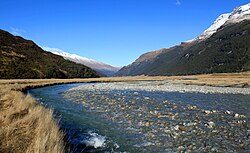River in New Zealand
| Rees River | |
|---|---|
 | |
| Native name | |
| Location | |
| Country | New Zealand |
| Physical characteristics | |
| Mouth | |
| • location | Glenorchy |
| • elevation | 320 m |
| Length | 41 km |
| Basin size | 406 km |
| Discharge | |
| • average | 26 cumecs |
The Rees River (Māori language: Puahiri or Puahere) is a headwater tributary of the Clutha River / Mata-Au that drains eastward of the main divide of the Southern Alps / Kā Tiritiri o te Moana in New Zealand. The river runs 41 km, drains an area of 406 km, and discharges into the head of Lake Wakatipu at Glenorchy. Bound by the Richardson (Whakaari) Mountains to the east and the Forbes Mountains to the west, its snow-covered headwaters rise above 2000 m.
The upper parts of the Rees River occupy a formerly glaciated valley that was fed by the Tyndall Glacier, which now drains into the adjacent Dart Valley. Below Rees Saddle the river valley is constrained by a series of steep alluvial fans that are fed from tributary basins. The lithology of the Rees catchment is highly erodible schist of the Aspiring lithologic association. The underlying schist is highly fissive due to its fine-grain, segregated quart-feldspar-mica composition.
The Rees valley, covered in tussock and native forest, is a popular location for recreational fly fishing, pack rafting and tramping, including the Rees and Dart Tracks, a five-day loop which crosses from the upper reaches of the Rees into the valley of the Dart River / Te Awa Whakatipu. However, the steep hillsides, easily erodible rock, proximity to the Alpine Fault, and intense rainfalls contribute to geohazard risks in the region. A debris flow swept away a hiker during a river crossing in an unnamed tributary in the Upper Rees Valley near Cleft Peak in January 2002.
The Rees river and valley get their gazetted name from the high country station, was originally part of the runs established by William Gilbert Rees, the first sheep farmer in the Wakatipu Basin. Ownership of the station has been in the Scott family since 1905; the Rees Valley Station is maintained in perpetuity as a part of Crown Pastoral Lease.
In popular culture
The lower Rees Valley, which continues to operate as a beef and sheep grazing farm, was a filming location for Mission: Impossible – Fallout, and the television drama series Top of the Lake.
See also
References
- "Puahiri / Puahere". Kā Huru Manu. Nga Rūnanga o Ngāi Tahu. Retrieved 2 February 2021.
- ^ Cook, Simon J.; Quincey, Duncan J.; Brasington, James (2 January 2014). "Geomorphology of the Rees Valley, Otago, New Zealand". Journal of Maps. 10 (1): 136–150. doi:10.1080/17445647.2013.863744. ISSN 1744-5647.
- "Place name detail: "Whakaari"". New Zealand Gazetteer. New Zealand Geographic Board. Retrieved 25 July 2022.
- "Place name detail: "Forbes Mountains"". New Zealand Gazetteer. New Zealand Geographic Board. Retrieved 25 July 2022.
- Turnbull, I. M. (2000). Geology of the Wakatipu Area, Institute of Geological and Nuclear Sciences 1:250,000 geological map 18. 1 sheet + 72 p. Lower Hutt, New Zealand, Institute of Geological and Nuclear Limited.
- ^ McSaveney, M.J., Glassey, P.J. 2002. The fatal Cleft Peak debris flow of 3 January 2002, Upper Rees Valley, West Otago Institute of Geological & Nuclear Sciences science report 2002/03. 28 p.
- "Rees-Dart Track". New Zealand Department of Conservation. Retrieved 28 August 2009.
- "Place name detail: Rees River". New Zealand Gazetteer. New Zealand Geographic Board. Retrieved 2 February 2021.
- Reed, A. W. (1975). Place names of New Zealand. Wellington: A.H. & A.W. Reed Ltd. p. 357
- "A cruise in Queenstown". Otago Daily Times. 2018.
44°51′S 168°23′E / 44.850°S 168.383°E / -44.850; 168.383
Categories: